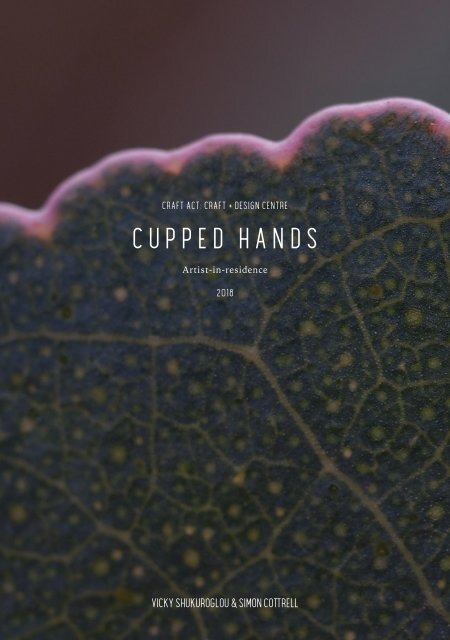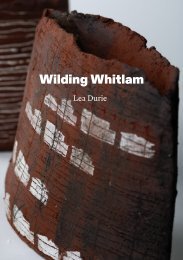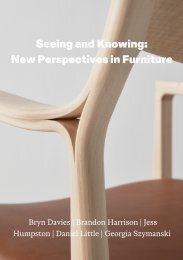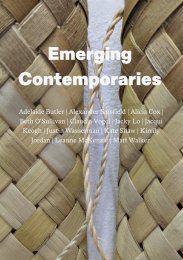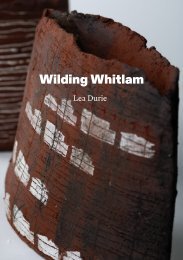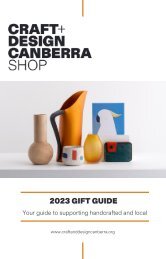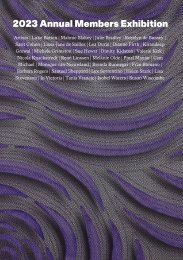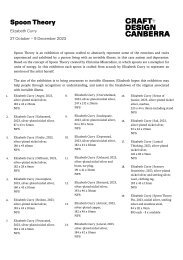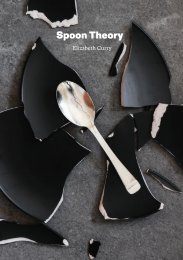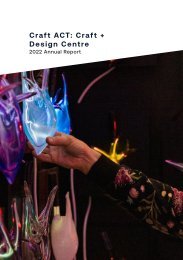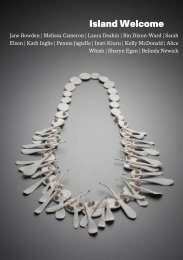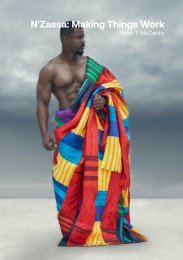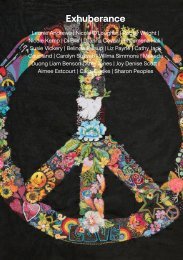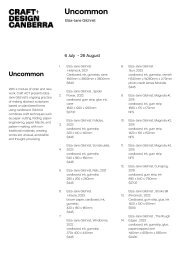Craft ACT Artist-in-residence 2018: Cupped Hands
Vicky Shukuroglou and Simon Cottrell
Vicky Shukuroglou and Simon Cottrell
You also want an ePaper? Increase the reach of your titles
YUMPU automatically turns print PDFs into web optimized ePapers that Google loves.
CRAFT <strong>ACT</strong>: CRAFT + DESIGN CENTRE<br />
CUPPED HANDS<br />
<strong>Artist</strong>-<strong>in</strong>-<strong>residence</strong><br />
<strong>2018</strong><br />
VICKY SHUKUROGLOU & SIMON COTTRELL
CRAFT <strong>ACT</strong><br />
<strong>2018</strong> ARTISTS-IN-RESIDENCE<br />
Vicky Shukuroglou<br />
Simon Cottrell<br />
LOCATIONS<br />
Gudgenby Ready-Cut Cottage, Namadgi<br />
National Park, Australian Capital Territory<br />
Australian National Botanic Gardens<br />
PROGRAM PARTNER (SINCE 2006)<br />
<strong>ACT</strong> Parks and Conservation Service<br />
Brett McNamara and Mel Barton + team<br />
<strong>2018</strong> RESEARCH PARTNER<br />
Australian National Botanic Gardens<br />
CRAFT <strong>ACT</strong> RESIDENCY TEAM<br />
Rachael Coghlan (CEO + <strong>Artist</strong>ic Director)<br />
Richilde Flavell (fmr Community Manager)<br />
Paula Llull (Gallery Manager)<br />
Caren Florance (Membership Coord<strong>in</strong>ator)<br />
Madisyn Zabel (Retail Coord<strong>in</strong>ator)<br />
PUBLIC PROGRAM<br />
Gudgenby Ready-Cut Cottage open day<br />
21 April <strong>2018</strong><br />
EXHIBITION<br />
<strong>Cupped</strong> <strong>Hands</strong><br />
<strong>Craft</strong> <strong>ACT</strong>: <strong>Craft</strong> + Design Centre<br />
21 March-11 May 2019<br />
<strong>Craft</strong> <strong>ACT</strong>: <strong>Craft</strong> + Design Centre acknowledges the<br />
Ngunnawal people as the traditional custodians<br />
of the <strong>ACT</strong> and surround<strong>in</strong>g areas. We honour<br />
and respect their ongo<strong>in</strong>g cultural and spiritual<br />
connections to this country and the contribution<br />
they make to the life of this city and region. We<br />
also acknowledge other Aborig<strong>in</strong>al and Torres<br />
Strait Islander peoples that have made Canberra<br />
their home and we aim to respect cultural heritage,<br />
customs and beliefs of all Indigenous peoples.<br />
<strong>Craft</strong> <strong>ACT</strong>: <strong>Craft</strong> + Design Centre<br />
Level 1 North Build<strong>in</strong>g<br />
180 London Circuit, Canberra<br />
www.craftact.org.au<br />
T (02) 6262 9333<br />
<strong>Craft</strong> <strong>ACT</strong> shop + gallery hours<br />
Tuesday to Friday 10am–5pm<br />
Saturday 12–4 pm<br />
Publisher: <strong>Craft</strong> <strong>ACT</strong>: <strong>Craft</strong> + Design Centre<br />
Graphic Design Template: Amy Cox<br />
Pr<strong>in</strong>t<strong>in</strong>g: Br<strong>in</strong>dabella Pr<strong>in</strong>t<br />
ABN: 33 314 092 587<br />
© <strong>Craft</strong> <strong>ACT</strong>: <strong>Craft</strong> + Design Centre 2020<br />
Cover Image: Crenulated marg<strong>in</strong>s of Eucalyptus bridgesiana<br />
juvenile leaf. Photo: Vicky Shukuroglou<br />
Page 4-5: Namadgi National Park. Photo: 5 Foot Photography<br />
2
CONTENTS<br />
INTRODUCTION: THE NATURE OF GROWTH<br />
Rachael Coghlan, CEO + <strong>Artist</strong>ic Director<br />
<strong>Craft</strong> <strong>ACT</strong>: <strong>Craft</strong> + Design Centre<br />
GUDGENBY VALLEY — ONE VALLEY MANY STORIES<br />
Brett McNamara<br />
AUSTRALIA’S NATURAL CAPITAL<br />
David Taylor<br />
ESSAY: NAMADGI<br />
Bruce Pascoe<br />
CUPPED HANDS<br />
Vicky Shukuroglou<br />
MIND<br />
Vicky Shukuroglou and Simon Cottrell<br />
ARTISTS’ BIOGRAPHIES<br />
EXHIBITION REVIEW<br />
ACKNOWLEDGEMENTS<br />
6-7<br />
10-11<br />
14-15<br />
20-23<br />
28-31<br />
32-33<br />
34-37<br />
40-41<br />
46-47<br />
3
4
5
6
THE NATURE OF GROWTH<br />
Dr Rachael Coghlan, CEO + <strong>Artist</strong>ic Director,<br />
<strong>Craft</strong> <strong>ACT</strong>: <strong>Craft</strong> + Design Centre<br />
When I th<strong>in</strong>k of the <strong>Craft</strong> <strong>ACT</strong> artist-<strong>in</strong>-<strong>residence</strong><br />
program I th<strong>in</strong>k of growth.<br />
<strong>Artist</strong>s grow their practice when they become<br />
cultural <strong>in</strong>terpreters of the landscape and its history<br />
dur<strong>in</strong>g their stay at Ready-Cut Cottage <strong>in</strong> the<br />
Gudgenby Valley at Namadgi National Park. Their<br />
appreciation for our surround<strong>in</strong>g environment, its<br />
stories and culture, and its history grows through<br />
the experience. Importantly, understand<strong>in</strong>g and<br />
respect for the Ngunnawal people, the traditional<br />
custodians of the land, not only grows but deepens.<br />
Our <strong>2018</strong> artists-<strong>in</strong>-<strong>residence</strong> are no exception: Vicky<br />
Shukuroglou and Simon Cottrell undertook valuable<br />
research at the Australian National Botanic Gardens<br />
and immersed themselves <strong>in</strong> Namadgi National<br />
Park and our Indigenous heritage to, as they urge<br />
us, ‘heighten compassion through strengthen<strong>in</strong>g<br />
connections to country’. <strong>Craft</strong> <strong>ACT</strong>’s relationship<br />
with the residency program partner, <strong>ACT</strong> Parks<br />
and Conservation, grows closer with every year.<br />
Namadgi National Park Manager Brett McNamara<br />
(who founded this residency with former <strong>Craft</strong> <strong>ACT</strong><br />
Executive Director Barb McConchie <strong>in</strong> 2006) and<br />
Visitor Experience Manager Mel Barton have become<br />
close collaborators with <strong>Craft</strong> <strong>ACT</strong>. Their expertise<br />
is <strong>in</strong>spir<strong>in</strong>g and we learn from them through every<br />
project. Their love for our region, our environment<br />
and its heritage br<strong>in</strong>gs a new context and a broader<br />
perspective to <strong>in</strong>form the work that we do <strong>in</strong><br />
support<strong>in</strong>g artists, craft practitioners, designers<br />
and makers at every stage of their careers, and<br />
promot<strong>in</strong>g and celebrat<strong>in</strong>g excellence and <strong>in</strong>novation<br />
<strong>in</strong> contemporary craft.<br />
two years. <strong>Craft</strong> <strong>ACT</strong> now offers two residencies<br />
each year. In addition to the three-week autumn<br />
Ready-Cut Cottage residency which leads to a group<br />
exhibition <strong>in</strong> our gallery the follow<strong>in</strong>g year, we<br />
now offer a second residency <strong>in</strong> spr<strong>in</strong>g. Our spr<strong>in</strong>g<br />
residency is held over n<strong>in</strong>e days, last year at a cottage<br />
overlook<strong>in</strong>g Cor<strong>in</strong> Dam. Participat<strong>in</strong>g artists are<br />
not required to create new work for an exhibition;<br />
however this spr<strong>in</strong>g residency, <strong>in</strong> just two years, has<br />
grown. In partnership with Tuggeranong Arts Centre,<br />
an exhibition of work from spr<strong>in</strong>g residents is<br />
presented <strong>in</strong> their gallery close to the national park<br />
which provided the <strong>in</strong>spiration.<br />
It is perhaps <strong>in</strong>evitable that a nature-based residency<br />
is about growth and is grow<strong>in</strong>g. As we approach our<br />
50th anniversary <strong>in</strong> 2021, <strong>Craft</strong> <strong>ACT</strong> is reflect<strong>in</strong>g<br />
on our history and opportunities for the future. I<br />
feel gratitude for the <strong>ACT</strong> Parks and Conservation<br />
Service and their cont<strong>in</strong>u<strong>in</strong>g and <strong>in</strong>valuable support.<br />
Thanks to our deeply engaged <strong>2018</strong> artists, Vicky<br />
and Simon, writer Bruce Pascoe, and the teams<br />
at <strong>Craft</strong> <strong>ACT</strong> and the Australian National Botanic<br />
Gardens, this acclaimed residency cont<strong>in</strong>ues to offer<br />
rich opportunities. <strong>Cupped</strong> <strong>Hands</strong> will help to grow<br />
our contribution to the contemporary craft and<br />
design sector, deepen relationships with our natural<br />
environment and honour the Indigenous heritage<br />
and connections to country.<br />
Our audiences who visit the <strong>Craft</strong> <strong>ACT</strong> gallery or<br />
read the catalogue, grow their understand<strong>in</strong>g of the<br />
power of art to tell stories, br<strong>in</strong>g new perspectives,<br />
and shed light on our world.<br />
Given this strong base for our acclaimed residency,<br />
and <strong>in</strong>creas<strong>in</strong>g <strong>in</strong>terest <strong>in</strong> participat<strong>in</strong>g, I have<br />
been delighted to grow the program over the past<br />
Opposite page: Small hill, small Vicky, large tree, large rocks.<br />
Photo: Simon Cottrell<br />
Page 8-9: Namadgi National Park. Photo: 5 Foot Photography<br />
7
8
9
GUDGENBY VALLEY — ONE VALLEY MANY STORIES<br />
Brett McNamara, Manager, Namadgi National Park,<br />
<strong>ACT</strong> Parks & Conservation Service<br />
Residency partner s<strong>in</strong>ce 2006<br />
In 1826 the Murrumbidgee River represented the<br />
‘limit of occupation’ for it was forbidden for newly<br />
arrived European immigrants to venture further<br />
west.<br />
This of course is juxtaposed to what we know today<br />
as to the movement of people across an ancient<br />
landscape. The orig<strong>in</strong>al <strong>in</strong>habitants of this rich<br />
cultural landscape. A mounta<strong>in</strong>ous landscape.<br />
In limit<strong>in</strong>g the squatter’s appetite for expansion,<br />
the laws at the time attempted to impede the<br />
unregulated acquisition of land. There weren’t<br />
enough police to ensure law and order.<br />
A venturous settler soon moved beyond this ‘limit’<br />
tak<strong>in</strong>g up land <strong>in</strong> an isolated valley high <strong>in</strong> the<br />
rugged mounta<strong>in</strong>s. An open grassy valley offer<strong>in</strong>g<br />
seem<strong>in</strong>gly limitless opportunities to fatten<strong>in</strong>g<br />
ravenous stock. He called it Gudgenby. The year<br />
was 1844.<br />
As this settler surveyed this majestic valley, local<br />
Aborig<strong>in</strong>al tribes gathered, feast<strong>in</strong>g on prote<strong>in</strong> rich<br />
Bogong moths, celebrat<strong>in</strong>g <strong>in</strong> corroboree, pa<strong>in</strong>t<strong>in</strong>g<br />
their dream time stories on rocks shelters which are<br />
still visible today.<br />
More Europeans ventured <strong>in</strong>to this hidden valley.<br />
Each seek<strong>in</strong>g to prosper from its natural resources.<br />
In time foresters would seek out opportunities to<br />
plant a commercial p<strong>in</strong>e forest. To grow softwood<br />
timber <strong>in</strong> this distant valley. The year was 1966.<br />
With the passage of time this beautiful valley was<br />
afforded protection, conserved, set aside given its<br />
<strong>in</strong>tr<strong>in</strong>sic natural and cultural values. A national park<br />
for the Nation’s Capital was declared. The year was<br />
1984.<br />
the heart of the Gudgenby Valley. As large forestry<br />
mach<strong>in</strong>ery rolled <strong>in</strong>to this idyllic valley, mature<br />
p<strong>in</strong>e trees crashed to the forest floor. Local native<br />
seeds were collected, stored away for future use,<br />
nurtured with time, to be planted where p<strong>in</strong>es once<br />
stood.<br />
The vision to restore the ecological <strong>in</strong>tegrity<br />
with<strong>in</strong> this valley sowed the seeds for remarkable,<br />
passionate community groups.<br />
In craft<strong>in</strong>g new chapters different people have heard<br />
the call to this valley. <strong>Artist</strong>s and craft practitioners<br />
have arrived, <strong>in</strong>spired by nature, creat<strong>in</strong>g creative<br />
works, draw<strong>in</strong>g <strong>in</strong>spiration from their immersion.<br />
Today this sense of creativity has been flow<strong>in</strong>g from<br />
the mounta<strong>in</strong>s, creat<strong>in</strong>g a rich repository of diverse<br />
work, each speak<strong>in</strong>g of time spent <strong>in</strong> nature.<br />
The values underp<strong>in</strong>n<strong>in</strong>g the artist-<strong>in</strong>-<strong>residence</strong><br />
philosophy are one’s we <strong>in</strong>st<strong>in</strong>ctively appreciate. We<br />
are not separate from nature but a part of it: this is<br />
not an <strong>in</strong>novative concept, but a rek<strong>in</strong>dl<strong>in</strong>g of what<br />
our forbearers understood. Spend<strong>in</strong>g time <strong>in</strong> nature,<br />
connect<strong>in</strong>g with nature is good for the m<strong>in</strong>d, the<br />
body and the soul. Nature can <strong>in</strong>deed nurture.<br />
It is to this sense of immersion that Vicky<br />
Shukuroglou and Simon Cottrell came to this<br />
valley.<br />
As a body of artistic works <strong>Cupped</strong> <strong>Hands</strong> represents<br />
a considered yet reflective period of natural<br />
immersion. It asks us to reflect, it questions our<br />
ability to enquire. To make sense of the world around<br />
us, a cultural world, a natural world.<br />
With the declaration of Namadgi National Park<br />
moves were afoot to remove this exotic p<strong>in</strong>e<br />
plantation, to rehabilitate a fragmented landscape <strong>in</strong><br />
10
Top: Gudgenby Hut, old fences and thistles.<br />
Photo: 5 Foot Photography<br />
Bottom left and right: Open day.<br />
Photo: 5 Foot Photography<br />
11
12
13
14
AUSTRALIA’S NATURAL CAPITAL<br />
Dave Taylor, Curator, Liv<strong>in</strong>g Collections<br />
Australian National Botanic Gardens<br />
<strong>2018</strong> Research Partner<br />
From the time Simon Cottrell and Vicky<br />
Shukuroglou’s research at the Australian National<br />
Botanic Gardens started it was clear that their work<br />
was likely to dig deep <strong>in</strong>to the connections between<br />
the Australian landscape and us as people liv<strong>in</strong>g <strong>in</strong>,<br />
and with it.<br />
As their work unfolded, matured and unraveled, this<br />
narrative strengthened and what has spilled out the<br />
other end is material and work that is set to provoke<br />
thought on what our country means to us, to others,<br />
and to <strong>in</strong>vite us to consider gett<strong>in</strong>g a little more<br />
close and personal with it.<br />
The work will no doubt generate different feel<strong>in</strong>gs<br />
and mean<strong>in</strong>g to each person who will see it, as it<br />
packs (an at times) subtle, but strong undercurrent<br />
punch, almost <strong>in</strong>sist<strong>in</strong>g that you need to relax and<br />
take it all <strong>in</strong>. The material unveils <strong>in</strong>timate detail<br />
wrapped <strong>in</strong> observations and thoughts from a unique<br />
part of our landscape. For some this may challenge<br />
us to consider what it means to us personally,<br />
provok<strong>in</strong>g thought for what custodianship may look<br />
like <strong>in</strong> the future. It is also likely that others, even<br />
those with a wellhoned eye, will be <strong>in</strong>spired to have<br />
another look at what is unique and special about<br />
our place <strong>in</strong> the world. The door is left open for<br />
us to consider how we may support, endorse and<br />
potentially take action for how we see ‘our place’<br />
looked after <strong>in</strong> the future, and how we value it and<br />
all its unique elements and responsibilities.<br />
The way Vicky and Simon have worked with us, and<br />
observ<strong>in</strong>g their genu<strong>in</strong>e focus and passion for the<br />
narrative, suggests this will not be a flash <strong>in</strong> the<br />
pan, and we are hop<strong>in</strong>g we have the opportunity<br />
to cont<strong>in</strong>ue this collaborative effort with them to<br />
<strong>in</strong>spire people to connect better <strong>in</strong> new and old ways<br />
with Australia’s natural capital.<br />
Page 12-13: Namadgi National Park.<br />
Photo: 5 Foot Photography<br />
Opposite: Simon Cottrell and Vicky Shukuroglou <strong>in</strong> the<br />
Australian National Botanic Gardens ra<strong>in</strong>forest gully.<br />
Photo: 5 Foot Photography<br />
15
16<br />
Simon Cottrell and Vicky Shukuroglou at the Australian National Botanic<br />
Gardens dur<strong>in</strong>g their research period. Photos: 5 Foot Photography
17
18<br />
Australian National Botanic Gardens. Photos: 5 Foot Photography
19
NAMADGI<br />
Bruce Pascoe, a Bunurong, Yu<strong>in</strong> and Tasmania man<br />
born <strong>in</strong> Melbourne suburb of Richmond and an<br />
award-w<strong>in</strong>n<strong>in</strong>g writer<br />
Your country wants to talk to you. It needs to talk to<br />
you. We need to listen.<br />
A d<strong>in</strong>go observes the climbers ascend<strong>in</strong>g a rocky<br />
mount. It watches, ears jigged forward, wonder<strong>in</strong>g.<br />
The people keep climb<strong>in</strong>g and he sits on a boulder to<br />
watch. He has a reason.<br />
As soon as he is seen he bounds off the boulder but<br />
his curiosity and need cause him to pause. They<br />
see him and wonder at his rich golden pelt, his<br />
<strong>in</strong>telligent eye, his need for conversation. He sniffs,<br />
he plays, he suggests, he proffers a wounded foot.<br />
There is an exchange of <strong>in</strong>timacy between two<br />
entirely different creatures.<br />
A strange, beautiful and puzzl<strong>in</strong>g conversation with<br />
Australia.<br />
On the flat land below the mount, a beast is seen<br />
loung<strong>in</strong>g on an emerald sward. Alone.<br />
What is this creature that looks most of all like a<br />
casual camel? It is an earless kangaroo. Some years<br />
ago, d<strong>in</strong>goes hatched a plan to br<strong>in</strong>g down the roo<br />
but his vicious kicks ga<strong>in</strong>ed him a reprieve as the<br />
d<strong>in</strong>goes withdrew to catch their breath. The roo lost<br />
an ear. The d<strong>in</strong>goes returned, haul<strong>in</strong>g him to the<br />
ground. Once aga<strong>in</strong> the roo fights back, but loses<br />
the other ear. He survives. Camel headed. So this<br />
valorous earless roo becomes known as V<strong>in</strong>cent and<br />
his presence is a constant rem<strong>in</strong>der of that tender<br />
balance between hunger, valour, energy and hope.<br />
Just above the elbow flat of the river where V<strong>in</strong>cent<br />
recl<strong>in</strong>es, almost always alone, a ris<strong>in</strong>g ridge l<strong>in</strong>e<br />
displays a peculiar wall of stone. Built by humans.<br />
But which ones?<br />
Moss and lichen grow slowly, <strong>in</strong>ch<strong>in</strong>g over centuries,<br />
creep<strong>in</strong>g over aeons, so their passage across the<br />
<strong>in</strong>tersections of stones speaks of centuries. Black<br />
centuries.<br />
Elsewhere <strong>in</strong> this <strong>in</strong>credible valley, your valley,<br />
hardly visited, stone arrangements wait as puzzles<br />
do, a grandmother tree sprawls, not spectacular <strong>in</strong><br />
height but stupendous <strong>in</strong> her embrace of the valley<br />
floor.<br />
Ready-Cut Cottage was brought here by pastoralists<br />
to m<strong>in</strong>d sheep and she is a beautiful build<strong>in</strong>g <strong>in</strong> her<br />
modest simplicity but all about her are the tools of<br />
the world’s most modest civilization. Not modest<br />
<strong>in</strong> the sense of <strong>in</strong>nocence and <strong>in</strong>ability, but modest<br />
<strong>in</strong> demand upon the earth, modest <strong>in</strong> the refusal to<br />
abuse, the fervent desire to care and protect, that<br />
k<strong>in</strong>d of hopelessly unpopular conservatism.<br />
This is your Namadgi. Part of your country. She<br />
wants to talk to you. And she is.<br />
Listen for the frog near the Ready-Cut dra<strong>in</strong>, watch<br />
the kangaroo puzzl<strong>in</strong>g over the dew drip from the<br />
shed roof, watch the swallows and hawks cours<strong>in</strong>g<br />
Opposite Page: Pig digg<strong>in</strong>gs along the Naas Creek Fen.<br />
Photo: Vicky Shukuroglou.<br />
20
21
22
across the marsh, become mesmerised by the<br />
trickl<strong>in</strong>g water search<strong>in</strong>g for a course between the<br />
rocks, the wood ducks serene on the handrail of the<br />
bridge, and if you walk along the road search<strong>in</strong>g<br />
for <strong>in</strong>ternet access look away from the glow of your<br />
device for a moment, down at your feet, because here<br />
is a real feat, the tools of a people who managed this<br />
land for 100,000 years, an aeon without thistles,<br />
foxes, sheep or barbed wire.<br />
Look away from the glow of your device to where the<br />
sun lets her blood seep and drench where a woman<br />
seems to recl<strong>in</strong>e. Is she dy<strong>in</strong>g or liv<strong>in</strong>g? Is she from<br />
the ground or on the ground?<br />
This is your Namadgi, she is a mystery, a relic, a<br />
vibrant pulse <strong>in</strong> the earth, the frosty dawn jewels<br />
on the barbed wire are the pearls on the breast of a<br />
most beautiful woman.<br />
Your country.<br />
You can walk the valley as if it was a task but if your<br />
<strong>in</strong>tention is to immerse yourself <strong>in</strong> your country<br />
you need to walk slowly and with care. Vicky and<br />
Simon have done this, observ<strong>in</strong>g the m<strong>in</strong>utiae of<br />
this <strong>in</strong>credible world. Vicky Shukuroglou lets her<br />
camera roam, lets it rest, exam<strong>in</strong>e, honour, her art<br />
is to love country and allow a slow, almost forensic<br />
exam<strong>in</strong>ation if it were not for the gentleness of<br />
respect.<br />
A camera can be an eye but rarely a heart. This is<br />
your <strong>in</strong>vitation to enter this sacred valley, allow your<br />
breath to slow, allow your m<strong>in</strong>d repose, rest <strong>in</strong> the<br />
verdure of the valley and embrace these secrets. It’s<br />
your country after all. She is your responsibility.<br />
Opposite, top: Hawkmoth. Photo: Vicky Shukuroglou<br />
Opposite, bottom: Video still from Two restra<strong>in</strong>ts by<br />
Vicky Shukuroglou<br />
23
24
Wally Bell demonstrat<strong>in</strong>g cool burn, Yarralumla. Photo: Vicky Shukuroglou<br />
25
26
Video still from Who are you? Vicky Shukuroglou & Bruce Pascoe<br />
27
28
CUPPED HANDS<br />
Vicky Shukuroglou<br />
I give her my attention, she becomes my guardian.<br />
Or she always was. Her liver seems apparent and is<br />
the shape I seek <strong>in</strong> late light. He says he mustn’t<br />
look too closely.<br />
The valleys extend further than a day’s walk, their<br />
curves I cannot fully reta<strong>in</strong> <strong>in</strong> my m<strong>in</strong>d. I question<br />
the use of a map<br />
– thief of <strong>in</strong>st<strong>in</strong>ct and sens<strong>in</strong>g<br />
– and contemplate the value of rema<strong>in</strong><strong>in</strong>g subtly<br />
conscious of trust <strong>in</strong> one self while walk<strong>in</strong>g, and the<br />
significance of complete trust <strong>in</strong> country.<br />
These words are mistaken <strong>in</strong> their act of separat<strong>in</strong>g<br />
me and country, and the danger is to cause us all to<br />
be lost.<br />
NAMADGI<br />
The accent is on the first ‘a’.<br />
NGUNNAWAL<br />
The accent is on the u, pronounced ‘oo’. The g is<br />
almost silent. W<strong>in</strong>gs buffet the screen and <strong>in</strong> my<br />
half sleep I recognise the hawkmoth has returned.<br />
Now I know the back door also offers night shelter<br />
for a swallow. This expla<strong>in</strong>s the dropp<strong>in</strong>gs scattered,<br />
the density <strong>in</strong>dicat<strong>in</strong>g its roost. No nest. These are<br />
abundant <strong>in</strong> the shed which frames the relentless<br />
water drip. I often walk <strong>in</strong> that direction seek<strong>in</strong>g the<br />
thrill of see<strong>in</strong>g the young kangaroo, sp<strong>in</strong>dly dark<br />
arms dangl<strong>in</strong>g just as they do, peer<strong>in</strong>g <strong>in</strong> its crookneck<br />
way, <strong>in</strong>vestigat<strong>in</strong>g that drip.<br />
On the lower slopes stretch<strong>in</strong>g away from her liver,<br />
Cass<strong>in</strong>ia is well established and ra<strong>in</strong>s plumes of<br />
dis<strong>in</strong>tegrat<strong>in</strong>g flowers. They abrade my nostrils<br />
and push <strong>in</strong>to every crease of my cloth<strong>in</strong>g, <strong>in</strong>to the<br />
t<strong>in</strong>iest slits of scratched sk<strong>in</strong>. A bird of prey moves<br />
above the trees. Larger than a sparrowhawk? Smaller<br />
than a wedge tail. Pale colour<strong>in</strong>g from below, perhaps<br />
some mottl<strong>in</strong>g or band<strong>in</strong>g? Or leaves and light?<br />
Safe <strong>in</strong> the dense vegetation, a group of small birds<br />
gathers. I stop to watch and aga<strong>in</strong> wonder if this is a<br />
reciprocal curiosity as more and more fly <strong>in</strong>.<br />
I observe the contour I want to follow, assess<strong>in</strong>g<br />
open<strong>in</strong>gs <strong>in</strong> the vegetation. Small gullies, some thick<br />
with weeds, others bulg<strong>in</strong>g with sway<strong>in</strong>g tussocks.<br />
Briar rose, thistle, fleabane, and pig digg<strong>in</strong>gs are<br />
probably the worst of thet lot, protrud<strong>in</strong>g and<br />
dipp<strong>in</strong>g as jagged skeletons and graves of the recent<br />
past.<br />
In the distance, kangaroos give shape to the land as<br />
their jump disappears from view, <strong>in</strong>to the gro<strong>in</strong> of<br />
a small hill. Among them are V<strong>in</strong>nie Van, Curlytail,<br />
and the mad young Circle Maker. Every dawn opens<br />
my search for their dist<strong>in</strong>ct bodies, and mostly my<br />
heart rests.<br />
We must th<strong>in</strong>k about the beloved quail. Plump bird<br />
breasts, shaped like cupped hands, try<br />
to rema<strong>in</strong> hidden. Three of them slap off the ground,<br />
scatter and regroup. There’s a small depression<br />
near where they take off, some bare earth, perhaps a<br />
tussock slightly pressed at the base, and some other<br />
nudges that suggest shelter. Home? How tenuous,<br />
among the thump and power of kangaroo quarters<br />
and brilliant raptor eyes.<br />
. . .<br />
Opposite page: Tree shadow. Photo: Vicky Shukuroglou<br />
29
I am asked if I have noticed the grooves and<br />
curvatures, if I understand someth<strong>in</strong>g of their time.<br />
I am gently jostled about see<strong>in</strong>g the angles and<br />
crowd<strong>in</strong>g of stone, the pulled droop of a limb, the<br />
firm turn shaped by tempered force and ty<strong>in</strong>g. This<br />
conversation is constant and keeps me seek<strong>in</strong>g. My<br />
reply is confident on icy morn<strong>in</strong>gs, when I feel the<br />
warmth of the stone and its th<strong>in</strong> edge, its bulbs and<br />
concentric waves, the f<strong>in</strong>eness of its gra<strong>in</strong>. My reply<br />
ensures it is not enough for me to just walk on. We<br />
are all <strong>in</strong> terrible debt. I th<strong>in</strong>k of the old people,<br />
and what their m<strong>in</strong>ds would turn to. I th<strong>in</strong>k of their<br />
humanity, of m<strong>in</strong>e, of yours. I th<strong>in</strong>k of what it means<br />
to tread on this earth so used to the press<strong>in</strong>gs of<br />
soft feet, of the human animal, of every other animal<br />
mov<strong>in</strong>g across her surface and deep <strong>in</strong> her watery<br />
hollows. I wonder if this yearn<strong>in</strong>g for dance and<br />
song, from every limb and every chord, is really also<br />
hers, or is it only m<strong>in</strong>e?<br />
among the matted parts now <strong>in</strong>separable from blood<br />
and dust. What is my role here, <strong>in</strong> this land, strewn<br />
with criss-cross<strong>in</strong>g obstacles ly<strong>in</strong>g wait<strong>in</strong>g, laden<br />
with various teeth?<br />
We visit some months later and feel relief see<strong>in</strong>g the<br />
sign above the wash<strong>in</strong>g tubs has survived. Please<br />
leave all buckets upturned. I th<strong>in</strong>k back to the<br />
lizard’s sheen and punctuated pattern, its urgent<br />
need to escape. In wonder<strong>in</strong>g how long it would have<br />
taken for it to die with hard plastic beneath its body,<br />
I feel grateful for lov<strong>in</strong>g look<strong>in</strong>g.<br />
Everywhere we walk the ground has been deeply<br />
cared for, and not so long ago. Everywhere we sit,<br />
another has sat. S<strong>in</strong>g<strong>in</strong>g, griev<strong>in</strong>g, lov<strong>in</strong>g, eat<strong>in</strong>g,<br />
gr<strong>in</strong>d<strong>in</strong>g, feed<strong>in</strong>g, talk<strong>in</strong>g, wash<strong>in</strong>g, laugh<strong>in</strong>g,<br />
cutt<strong>in</strong>g, mak<strong>in</strong>g. Beneath our feet, beneath the roads,<br />
beneath our houses, lie stones handled by strong and<br />
dexterous hands, lie remnants of common meals.<br />
These shapes you might never see, even though they<br />
face you.<br />
Signatures of time and learn<strong>in</strong>gs shared, of love and<br />
resolved dispute, merge and disappear if we are not<br />
slow enough to see. Does your <strong>in</strong>timacy reveal the<br />
difference between frosty valleys naturally bear<strong>in</strong>g<br />
no trees, and those whose trees were taken without<br />
consent?<br />
Do we acknowledge absence when we see it, and<br />
does it change our thought? I hear the ducks before<br />
they bustle <strong>in</strong>, arrang<strong>in</strong>g themselves on the bridge.<br />
I wait for the cockatoos who, at this time of day, <strong>in</strong><br />
this mood of light, blaze the sunset on the underside<br />
of their w<strong>in</strong>gs. They dip and turn and flare their<br />
crests, ready<strong>in</strong>g for the night. Their flight path, how<br />
long has it been so? And that poised flock of yellow<br />
tails, hundreds of valleys and pla<strong>in</strong>s from here, what<br />
drives their path above lanes of cars and trucks? My<br />
sk<strong>in</strong> stiffens at the prevalence of tangled heritage.<br />
In days to come a small parched strap of marsupial<br />
hangs from one of the barbs, as though we need to<br />
rem<strong>in</strong>d ourselves. Some fur reta<strong>in</strong>s its gentle frizz<br />
Top: Fall<strong>in</strong>g Cass<strong>in</strong>ia flowers.<br />
Bottom: Gudgenby River.<br />
Opposite: Rock shelter.<br />
Photos: Vicky Shukuroglou.<br />
30
31
MIND<br />
Vicky Shukuroglou & Simon Cottrell<br />
S<strong>in</strong>ce early childhood we have both been closely<br />
observ<strong>in</strong>g the ‘natural world’, with a strong sense of<br />
be<strong>in</strong>g a part of ‘nature’, not separate to it. For the<br />
last 25 years we have walked thousands of kilometres<br />
together, learn<strong>in</strong>g through <strong>in</strong>timate experience of<br />
this remarkable and ancient land. To delve deeper<br />
we’ve needed to be open-m<strong>in</strong>ded and question all<br />
that we do not understand. We must also question<br />
what we th<strong>in</strong>k we understand. Curiosity and care are<br />
vital here. They are the antidote to assumption or<br />
superficial op<strong>in</strong>ion. This is the ethos which guides<br />
our work.<br />
biodiversity; people who record the provenance of<br />
every <strong>in</strong>dividual plant on the 40 hectare site. Bear<br />
<strong>in</strong> m<strong>in</strong>d you won’t see a larger liv<strong>in</strong>g collection<br />
of Australian plants. At the ANBG you will also<br />
f<strong>in</strong>d a remarkable range of volunteers, who, <strong>in</strong><br />
understand<strong>in</strong>g the significance of the work, f<strong>in</strong>d<br />
the will to contribute their care, time and energy.<br />
They weed the gardens, walk with visitors to unveil<br />
the f<strong>in</strong>e layers of botanical complexity, and lov<strong>in</strong>gly<br />
gather and clean thousands of seeds for the security<br />
and rehabilitation of our country. Australia, you have<br />
a treasure here.<br />
In many ways a project like <strong>Cupped</strong> <strong>Hands</strong> has<br />
been wait<strong>in</strong>g at our core, and we are grateful for<br />
the opportunities this residency enables. Through<br />
our collaboration we seek to awaken the senses to<br />
the <strong>in</strong>f<strong>in</strong>ite complexity of ecosystems with<strong>in</strong> which<br />
humans have evolved. By <strong>in</strong>vit<strong>in</strong>g hearts and m<strong>in</strong>ds<br />
to become deeply immersed <strong>in</strong> these relationships,<br />
we aim to reignite curiosity and reverence for our<br />
earth. We hope to heighten compassion through<br />
strengthen<strong>in</strong>g connections to country.<br />
We have long known that the Australian National<br />
Botanic Gardens (ANBG) is a place of rigorous<br />
research, not just an enchant<strong>in</strong>g and biodiverse<br />
garden. Dur<strong>in</strong>g our residency, the more we looked<br />
the more we learnt, the more we acknowledged<br />
how much there is to know. The more we learnt<br />
the more deeply we understood its complexity.<br />
We experienced the ANBG’s generous spirit, and<br />
we cont<strong>in</strong>ue to be enthralled by the aspirations of<br />
the many people <strong>in</strong>volved. Walk <strong>in</strong>to the offices,<br />
the cryptogam, herbarium, nursery, or seed bank,<br />
and you will discover people work<strong>in</strong>g with fervent<br />
commitment and collaboration, through careful<br />
observation and gentle response. You may meet<br />
people who have been work<strong>in</strong>g on one rare species<br />
for 25 years, rebuild<strong>in</strong>g its genetic strength that has<br />
dim<strong>in</strong>ished under recent human presence; people<br />
who collaborate with similar <strong>in</strong>stitutions across the<br />
world aim<strong>in</strong>g to understand and preserve the earth’s<br />
Let’s consider that Australia has more known<br />
endemic species than any other country.<br />
That means approximately 87% of Australia’s<br />
mammals, 45% of birds, 86% of vascular plants,<br />
93% of reptiles and 94% of amphibians are found<br />
NOWHERE ELSE ON EARTH. 1 Can we ignore these<br />
facts <strong>in</strong> our every day? Whose responsibility is it to<br />
ensure the vitality of the earth that susta<strong>in</strong>s all life?<br />
There are valleys, fens, peaks, rivers and grasslands<br />
of Namadgi National Park replete with ancient signs<br />
of care and attention. We can see the evidence <strong>in</strong><br />
the soils that are alive and held together; <strong>in</strong> the<br />
abundance of Kangaroo grass which was — and may<br />
be once aga<strong>in</strong> — a staple food for people; and <strong>in</strong> the<br />
ease with which we can walk, our only fair hurdles<br />
be<strong>in</strong>g rocks, steep slopes, waterways. But we can<br />
also see recent scars that need heal<strong>in</strong>g.<br />
While at Namadgi, our long daily meander<strong>in</strong>gs<br />
presented questions that we could not easily<br />
answer. We thought about the ANBG, and the<br />
<strong>in</strong>dividuals work<strong>in</strong>g hard to understand species,<br />
what is required for their right to exist, and about<br />
whose responsibility it is to ensure that the decl<strong>in</strong>e<br />
of ecosystems is stopped. We contemplated the<br />
Gudgenby area described as ‘a highly manipulated<br />
landscape’ 2 and wondered what we would be leav<strong>in</strong>g<br />
32
eh<strong>in</strong>d <strong>in</strong> traces of our presence. We hoped very<br />
little. As we walked, we wondered about whose<br />
hearts must ache for the land that is no longer<br />
abundant with cultivated lilies and grasses, tubers<br />
and gra<strong>in</strong>s, which fed and were nurtured by the<br />
rhythms of a peaceful land. We wondered about<br />
the knowledge held <strong>in</strong> the land, <strong>in</strong> the careful<br />
placement of rocks that could corral free roam<strong>in</strong>g<br />
kangaroos for an efficient hunt, and how these rocks<br />
are just natural rock-fall at a quick glance. Panicum<br />
decompositum was also a vital gra<strong>in</strong> for Australia’s<br />
Indigenous people across vast tracts of land. Today<br />
we see it <strong>in</strong> the warm months, piled up aga<strong>in</strong>st<br />
verandahs, blow<strong>in</strong>g across roads, and teeter<strong>in</strong>g <strong>in</strong><br />
wire fences. We wondered about restra<strong>in</strong>t, and the<br />
breadth of its mean<strong>in</strong>g.<br />
We are curious humans who recognise our capacity<br />
for change-mak<strong>in</strong>g. In work<strong>in</strong>g with others we<br />
trust <strong>in</strong> their capacity for the same, and know that<br />
every new perspective ga<strong>in</strong>ed can reveal more about<br />
ourselves, our fellow humans, and our earth and the<br />
life she susta<strong>in</strong>s.<br />
Vicky hold<strong>in</strong>g lily tubers from Naas Creek – once cultivated<br />
by the local Indigenous people, now dug up by feral pigs.<br />
Photo: Simon Cottrell<br />
33
34
ARTIST BIOGRAPHIES<br />
Simon Cottrell completed a BA of F<strong>in</strong>e Arts <strong>in</strong> Gold<br />
and Silversmith<strong>in</strong>g with Honours at RMIT University<br />
<strong>in</strong> 1996, where he also completed a Masters of<br />
Arts Research <strong>in</strong> 2010. He set up his first studio<br />
<strong>in</strong> Melbourne <strong>in</strong> 1998, focuss<strong>in</strong>g predom<strong>in</strong>antly on<br />
limited production jewellery works, us<strong>in</strong>g <strong>in</strong>dustrial<br />
waste materials. Dur<strong>in</strong>g this time he began to<br />
develop more complex oneoff pieces. Due to the<br />
<strong>in</strong>ternational attention that these one-off works<br />
began to attract, they quickly became his primary<br />
studio practice. These works have been exhibited <strong>in</strong><br />
over 150 exhibitions, locally and <strong>in</strong>ternationally.<br />
From 2001–2011 he was Associate Lecturer <strong>in</strong><br />
Metals and Jewellery at the School of Art Design<br />
and Architecture, Monash University, Melbourne,<br />
and lecturer <strong>in</strong> Gold and Silversmith<strong>in</strong>g at RMIT<br />
University. S<strong>in</strong>ce relocat<strong>in</strong>g his studio to Canberra<br />
<strong>in</strong> 2012, he has been a lecturer and researcher <strong>in</strong> the<br />
Jewellery and Object Workshop, School of Art and<br />
Design, at ANU. He is regularly <strong>in</strong>vited to present<br />
lectures and workshops across Europe, USA, Canada,<br />
Asia, Australia and New Zealand.<br />
His works are held <strong>in</strong> major public collections,<br />
<strong>in</strong>clud<strong>in</strong>g Die Neue Sammlung, P<strong>in</strong>akothek der<br />
Moderne, Munich, Germany; Museum Českého<br />
Ráje, Turnov, Czech Republic; E’space Solidor,<br />
Ville de Cagnes-Sur-Mer, France; National Gallery<br />
of Australia, Canberra; Art Gallery of Western<br />
Australia, Perth; National Contemporary Jewellery<br />
Collection, Griffith Regional Art Gallery, Griffith;<br />
National Gallery of Victoria, Melbourne; Art Gallery<br />
of South Australia, Adelaide; McMillan Collection,<br />
Royal Melbourne Institute of Technology, Melbourne.<br />
Opposite page: Simon Cottrell, Namadgi National Park.<br />
Photo: 5 Foot Photography<br />
35
ARTIST BIOGRAPHIES<br />
Vicky Shukuroglou is a multidiscipl<strong>in</strong>ary artist<br />
and researcher who dedicates herself to deepen<strong>in</strong>g<br />
her understand<strong>in</strong>g of the earth through careful<br />
observation and hands-on care of country, all of<br />
which guide and drive her creative process. In do<strong>in</strong>g<br />
so, she hopes to rouse your heart’s attention. Prior<br />
to, and s<strong>in</strong>ce complet<strong>in</strong>g her Master of Arts <strong>in</strong><br />
2009, she has worked <strong>in</strong> collaboration with writers,<br />
musicians, scientists, Indigenous communities,<br />
and young people. Vicky has developed creative<br />
pedagogies that stimulate participants’ sense of<br />
possibility, capacity, and motivation to learn and<br />
mean<strong>in</strong>gfully engage with their world. National and<br />
<strong>in</strong>ternational residencies, exhibitions, conferences<br />
and workshops contribute to the progression of<br />
her creative practice. This is a dynamic aspect<br />
of her work as an artist cont<strong>in</strong>ually learn<strong>in</strong>g<br />
and respond<strong>in</strong>g. In her commitment to shift<strong>in</strong>g<br />
perceptions and br<strong>in</strong>g<strong>in</strong>g the powerful work of young<br />
people to the attention of ‘grown-ups’, all sorts of<br />
remarkable projects have evolved. Vicky has worked<br />
<strong>in</strong> partnership with, and been supported by, various<br />
organisations <strong>in</strong>clud<strong>in</strong>g UNESCO, Sanskriti Kendra<br />
(India), Instituto Sacatar (Brazil), World <strong>Craft</strong>s<br />
Council, Salaam Baalak (India), Victorian Equal<br />
Opportunity and Human Rights Commission, City<br />
of Melbourne, Arts Victoria, Fed Square, schools and<br />
universities.<br />
Opposite page: Vicky at the Australian<br />
National Botanic Gardens dur<strong>in</strong>g the<br />
research period. Photo: 5 Foot Photography<br />
36
37
38
39
EXHIBITION REVIEW<br />
Written by Isabelle Mackay-Sim<br />
Most Canberra locals are familiar with Namadgi, our<br />
southwestern national park, and many would have<br />
bushwalked along its streams and heard wallabies<br />
rustle through its purple-flowered boronia bushes.<br />
But how well do you know the <strong>ACT</strong>’s very own<br />
wilderness? The vast bushland of Namadgi has<br />
boundless treasures to offer those who move slowly<br />
and contemplatively along the tracks tread for<br />
centuries by its traditional owners.<br />
This slow exploration was undertaken last year by<br />
artists Simon Cottrell and Vicky Shukuroglou dur<strong>in</strong>g<br />
their <strong>2018</strong> <strong>Craft</strong> <strong>ACT</strong> artist residency at Gudgenby<br />
Ready-Cut Cottage <strong>in</strong> the National Park. Simon is<br />
a contemporary jeweller who is also a lecturer and<br />
researcher <strong>in</strong> the jewellery workshop at the ANU<br />
school of art and design.<br />
For 25 years, he has shared a fasc<strong>in</strong>ation with the<br />
natural world with Vicki, a multidiscipl<strong>in</strong>ary artist<br />
and researcher. Together, they conducted research<br />
<strong>in</strong> the wild solitude of the park, as well as at the<br />
Australian National Botanic Gardens. In response to<br />
this experience, the two artists have created a quiet<br />
and personal body of work that reflects an <strong>in</strong>tense<br />
connection with the landscape of Namadgi, and a<br />
yearn<strong>in</strong>g for a deeper connection between humans<br />
and the country they move through.<br />
The exhibition <strong>in</strong>cludes a video collaboration with<br />
Bruce Pascoe, a Bunurong, Yu<strong>in</strong> and Tasmanian man<br />
and award-w<strong>in</strong>n<strong>in</strong>g writer of Dark Emu. This video is<br />
a poetic portrait of the private life of the Australian<br />
landscape, and an endorsement of tread<strong>in</strong>g lightly as<br />
we move across country, as traditional Australians<br />
have done.<br />
A feel<strong>in</strong>g of connection to the natural world is<br />
evident <strong>in</strong> Vicki Shukuroglou’s haunt<strong>in</strong>gly beautiful<br />
macroscopic photographs, which present snapshots<br />
from Namadgi and the Botanic Gardens.<br />
These works give a sense of <strong>in</strong>tense and emotional<br />
observation and speak of time devoted to mov<strong>in</strong>g<br />
slowly through the environment, open to its<br />
wonders.<br />
Vicki‘s compassion, curiosity and reverence reveals<br />
itself <strong>in</strong> her work as a multidiscipl<strong>in</strong>ary artist and<br />
researcher.<br />
“I th<strong>in</strong>k of the old people, and what their m<strong>in</strong>ds<br />
would turn to. I th<strong>in</strong>k of their humanity, of m<strong>in</strong>e, of<br />
yours. I th<strong>in</strong>k of what it means to tread on this earth<br />
so used to the press<strong>in</strong>gs of soft feet, of the human<br />
animal, of every other animal mov<strong>in</strong>g across her<br />
surface and deep <strong>in</strong>to her watery hollow.”<br />
This thoughtful and timely exhibition rem<strong>in</strong>ds us<br />
to slow down and immerse ourselves <strong>in</strong> the historic<br />
bushland at our f<strong>in</strong>gertips.<br />
As we move through our <strong>in</strong>creas<strong>in</strong>gly urbanised<br />
environment, it is both sober<strong>in</strong>g and reassur<strong>in</strong>g,<br />
but crucially important, to remember that we are<br />
human animals: part of an ecosystem that shaped<br />
our evolution and that we, <strong>in</strong> turn, shape with our<br />
every action.<br />
Orig<strong>in</strong>ally published on HerCanberra.<br />
The staff of the National Park are resound<strong>in</strong>gly<br />
supportive of this approach to co-exist<strong>in</strong>g <strong>in</strong> and<br />
with the natural landscape of the <strong>ACT</strong>. Namadgi<br />
Manager Brett McNamara is passionate about this<br />
relationship, expla<strong>in</strong><strong>in</strong>g “We are not separate from<br />
nature but a part of it: this is not an <strong>in</strong>novative<br />
concept, but a rek<strong>in</strong>dl<strong>in</strong>g of what our forebears<br />
understood.”<br />
Page 38-39: Namadgi National Park. Photo: 5 Foot Photography<br />
Opposite & page 42-45: <strong>Cupped</strong> hands exhibition at <strong>Craft</strong> <strong>ACT</strong>, 2019.<br />
Photos: 5 Foot Photography<br />
40
41
42
43
44
45
ACKNOWLEDGEMENTS<br />
The <strong>Craft</strong> <strong>ACT</strong>: <strong>Craft</strong> + Design Centre artist-<strong>in</strong>-<strong>residence</strong><br />
program has been generously supported by the <strong>ACT</strong> Parks<br />
and Conservation Service s<strong>in</strong>ce 2006. The Australian<br />
National Botanic Gardens has been our valued <strong>2018</strong> research<br />
partner. We would especially like to thank these <strong>in</strong>dividuals<br />
who have helped to make the residency program a success:<br />
<strong>ACT</strong> PARKS AND CONSERVATION SERVICE<br />
Brett McNamara (Manager, Namadgi National Park), Mel<br />
Barton (Manager, Visitor Services), Jess Enge (Visitor<br />
Services) and Craig Wa<strong>in</strong>wright (Ranger <strong>in</strong> Charge).<br />
AUSTRALIAN NATIONAL BOTANIC GARDENS<br />
David Taylor (Curator of Liv<strong>in</strong>g Collections), Megan<br />
Donaldson (Visitor Experience Coord<strong>in</strong>ator), Anna<br />
Monro (Botanical Information Manager), Joe McAuliffe<br />
(Nursery Manager), Tom North (Seed Bank Manager), Brook<br />
Cl<strong>in</strong>ton (Seed Bank Lab technician) and everyone else at the<br />
Seed Bank– <strong>in</strong>clud<strong>in</strong>g the spectacular volunteers and Chris<br />
Cargill (Curator of Cryptogam Herbarium).<br />
Vicky Shukuroglou and Simon Cottrell would like<br />
to thank:<br />
... this land which is used to be<strong>in</strong>g loved, is used to<br />
be<strong>in</strong>g given attention.<br />
We honour the traditional custodians whose presence<br />
on country has been gentle and nurtur<strong>in</strong>g. Ways of be<strong>in</strong>g<br />
that have evolved over 100,000 years have much to<br />
teach everyone when the priority and result is a thriv<strong>in</strong>g<br />
ecosystem. We would like to thank all those who have<br />
supported us along the way–your time, knowledge, and<br />
generosity of spirit is precious to us. You know who you are,<br />
and we are grateful We are very grateful for the support of<br />
ANU School of Art and Design, particularly Photography &<br />
Digital Media.<br />
Opposite page: Gudgenby depth. Photo: Vicky Shukuroglou
<strong>Craft</strong> <strong>ACT</strong>: <strong>Craft</strong> + Design Centre is supported by<br />
the <strong>ACT</strong> Government, the Visual Arts and <strong>Craft</strong><br />
Strategy - an <strong>in</strong>itiative of the Australian, State and<br />
Territory Governments, and the Australia Council for<br />
the Arts - the Australian Government’s arts fund<strong>in</strong>g<br />
and advisory body.<br />
<strong>Artist</strong>-<strong>in</strong>-<strong>residence</strong> Program Partner<br />
<strong>2018</strong> Research Partner<br />
<strong>Craft</strong> <strong>ACT</strong> is supported by<br />
Opposite page: <strong>Artist</strong>-<strong>in</strong>-<strong>residence</strong> open day <strong>2018</strong>,<br />
Ready-Cut Cottage, Namadgi National Park.<br />
Photo: 5 Foot Photography
50


